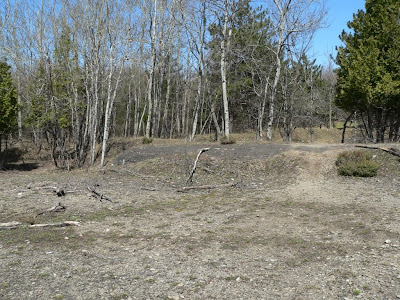Old Quarry Youth Mountain Bike Skills Park
Submission to the National Capital Commission Greenbelt Master Plan Review - Part 3
By Richard W. Woodley, environmentalist, hiker, mountain biker, snowshoer, cross
country skier, kayaker
(Please note: click on images to enlarge)
While this may seem like a my most radical proposal yet it follows naturally from what I have already written:
Getting people out into the environment, onto the lakes and rivers and into the forests builds healthy lifestyles, and healthy lifestyles improve our health and reduces our health care costs. This is important at a time when obesity, and childhood obesity in particular, is at epidemic levels. We need natural spaces and trails to teach our children the benefits and enjoyment that can be had in the great outdoors. The National Capital Region is fortunate that we have a population that celebrates healthy lifestyles and rises up to challenge those that want to take our natural spaces and trails away from us. Allowing mountain biking on the trails is one more way to encourage people to get out and enjoy nature.The Old Quarry are trails are particularly suited for young riders just starting out in mountain biking because they provide a wide range of difficulty from easy flat gravel trails to intermediate level rooty and rocky trails.
Young people need the type of challenges the outdoors can provide as an alternative to spending their time in a sedentary lifestyle centred on electronic devices, or other even worse, but seemingly exciting, activities like gangs and drugs. Youth can be attracted to these things by the very risks we want to protect them from. Outdoors activities such as rock climbing and mountain biking can provide exciting healthy risks that build character and a healthy body.
Mountain biking is the perfect activity to get young people active and out in the environment. It combines man and machine (or boy and machine) with a sense of adventure, all in a natural setting. The Greenbelt trails are the ideal location as many are closes to neighbourhoods and they have a wide variety of levels of riding difficulty and challenge.
A beginner level mountain bike skills park adjacent to these trails would be ideal for this location that is close to communities with young families and schools, as well as having it's own parking and close proximity to additional parking and facilities at the Hazeldean Mall.
The proposed location is off to the side of the trails and separated from roadways and traffic by bush.


There are two documented changes in young people's lives from when I grew up to today. They are a decreased level of physical activity and a disconnect from nature. Part of this stems from parents fear of letting their children play and wander outside alone and part of it stems from competition for their attention from technological devices from television to video games to the Internet.
We need to excite kids to get them to choose real outdoor physical activity over indoor virtual pursuits. Mountain biking is seen as an exciting "extreme" sport that can provide that excitement, yet when done with proper training at each individuals ability level it can be as safe as any other sporting activity.
A skills park can provide the setting and resources to teach young people how to handle their bikes safely and how to safely navigate technical mountain bike trails, as well as how to judge what they are capable of safely attempting on their bikes.
As well as including natural and man-made features to learn and practice their skills on, the park could also include educational displays on safe and responsible riding and respect for the trails, the environment and other trail users.
I believe this location is an excellent one for a beginner level mountain biking skills park as young riders can practice the skills they learn in the park on the adjacent trails that provide a wide range of trails of varying levels of technical difficulty.






I also intend to propose that a more advanced level skills park be established adjacent to the mountain biking trail system in the South March Highlands.

















